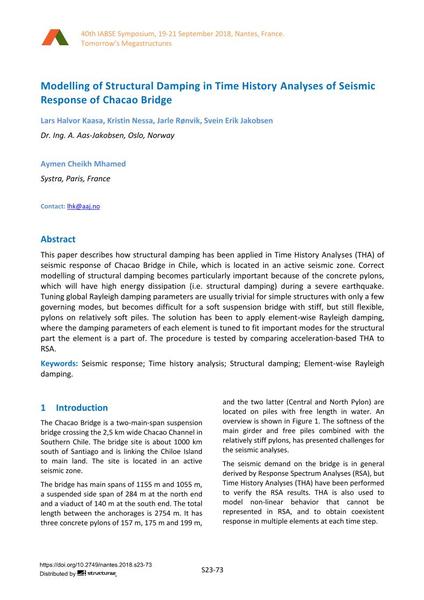Modelling of Structural Damping in Time History Analyses of Seismic Response of Chacao Bridge

|
|
|||||||||||
Détails bibliographiques
| Auteur(s): |
Lars Halvor Kaasa
(Dr. Ing. A. Aas-Jakobsen, Oslo, Norway)
Kristin Nessa (Dr. Ing. A. Aas-Jakobsen, Oslo, Norway) Jarle Rønvik (Dr. Ing. A. Aas-Jakobsen, Oslo, Norway) Svein Erik Jakobsen (Dr. Ing. A. Aas-Jakobsen, Oslo, Norway) Aymen Cheikh Mhamed (Systra, Paris, France) |
||||
|---|---|---|---|---|---|
| Médium: | papier de conférence | ||||
| Langue(s): | anglais | ||||
| Conférence: | IABSE Symposium: Tomorrow’s Megastructures, Nantes, France, 19-21 September 2018 | ||||
| Publié dans: | IABSE Symposium Nantes 2018 | ||||
|
|||||
| Page(s): | S23-73 | ||||
| Nombre total de pages (du PDF): | 9 | ||||
| DOI: | 10.2749/nantes.2018.s23-73 | ||||
| Abstrait: |
This paper describes how structural damping has been applied in Time History Analyses (THA) of seismic response of Chacao Bridge in Chile, which is located in an active seismic zone. Correct modelling of structural damping becomes particularly important because of the concrete pylons, which will have high energy dissipation (i.e. structural damping) during a severe earthquake. Tuning global Rayleigh damping parameters are usually trivial for simple structures with only a few governing modes, but becomes difficult for a soft suspension bridge with stiff, but still flexible, pylons on relatively soft piles. The solution has been to apply element-wise Rayleigh damping, where the damping parameters of each element is tuned to fit important modes for the structural part the element is a part of. The procedure is tested by comparing acceleration-based THA to RSA. |
||||
